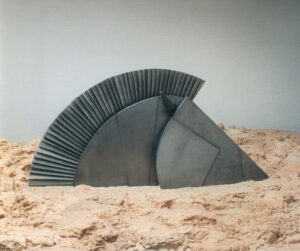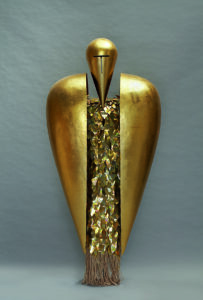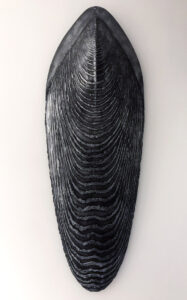From 25 October, it will be possible to discover an unprecedented aspect of the great master Pomodoro through guided Open Studio tours, in the recently renovated spaces of the Studio and Archives of Arnaldo Pomodoro. The Archive was born in the 1950s, when the artist began to collect press clippings and photographs with the aim of documenting his work. Over the years, catalogs, magazines and various publications, posters, postcards, cinematographic films and maquettes have been added. Documents, images and objects, constantly updated and protected, which have contributed to making the Archive full of new information and materials.
Artist, sculptor, goldsmith and great master, Arnaldo Pomodoro was born in Morciano di Romagna on 23 June 1926. He initially studied to become a surveyor, but later devoted himself to sculpture, with which he fell madly in love. His language evolves simultaneously with the creation of each work, transforming and adapting to the materials. From gold, to silver, passing through iron, wood, concrete and bronze, the most famous of the materials used in his works of art.
His iconic bronze spheres create an important contrast between the smooth surface and the complexity of the internal mechanism which, disintegrating and opening, captures the interest of the viewer and involves him in the exploration of his artistic research. A rigorous geometric influence prevails over the latter, manifesting itself in its most essential form. The different geometric elements are repeated in sections, rectilinear or circular, becoming similar to the scanning of the notes, in a musical composition.
Among his many life experiences, he has taught at the art departments of several US universities, including that of Stanford, California, Berkeley and Mills College. He also embarked on a theatrical journey, which has forged and influenced his style and artistic research. The Open studio visits in which it will be possible to participate, highlight the artist’s relationship with the world of theater and his path within it as a central focus.
It will be possible to admire and explore the projects and some unpublished works, including maquettes, fashion sketches, an original costume, design tables, scene photographs that will tell visitors about another area of the artist’s activity, often little known. As the artist himself says “Theater gives me a sense of creative freedom: it seems to me, in a certain sense, that I can materialize visionary”.
His relationship with the world of the theater began in his childhood, when he was a siparist at the opera house in Rimini. “The theatrical experience opened new horizons for me – writes Arnaldo Pomodoro – and stimulated me to experiment in the field of sculpture too, because theater gives me a sense of creative freedom: it seems to me, in a certain sense, that I can materialize visionary. In some projects for the stage, especially in the case of classical texts, I have created large spectacular machines from which I then drew real sculptures. In other cases I took inspiration from projects of unrealized sculptures “.
Among his great scenographic and theatrical works we can remember his experience together with Luca Ronconi for Kleist’s Das Kätchen von Heilbronn, staged in Zurich in 1972, which is entirely conceived on the water of Lake Zurich and places the spectators on rafts furniture that moves chasing those of the actors who act, then not made due to an accident during rehearsals and moved indoors.
The Open studios will be held within Arnaldo Pomodoro’s studio, where numerous activities are also held every month that analyze his sculptural techniques. This initiative marks a new step in the global project of conservation, enhancement and promotion of the Archive and its contents, promoted by the Foundation with the aim of favoring an ever wider knowledge of the artist and full accessibility to the public of its material and immaterial heritage. The enhancement of the Archive is then flanked by that of the Collection, through a series of initiatives spread throughout the territory, starting with the three-year loan for use of the monumental Obelisk for Cleopatra, located for the next three years in the square in front of the Campori di Soliera Castle (MO). Furthermore, until January 10th, at the Campori Castle, it will be possible to visit the Pomodoro {sur} face solo show.
It will be possible to admire within the exhibition works and projects that will allow the public to discover more about the artist’s theatrical journey. You can see the staging for Ahmad Shawqi’s The Passion of Cleopatra on the ruins of Gibellina (1989) and the original stage costumes, preparatory drawings and scenographic sketches, as well as photographs and videos of the show. And you will also be able to access the environmental work, Entrance into the labyrinth, about 170 square meters in patinated fiberglass with copper leaf, created and exhibited for the first time at the Campori di Soliera Castle. In the last room, visitors will be able to experience Labyr-Into, one of the first immersive applications in Italy in the field of contemporary art and the first ever dedicated to a work by Arnaldo Pomodoro, based on Gear’VR ‘technology and ‘Oculus’RifT made by Oliver Pavicevic and Steve Piccolo. There will also be a room designed for children, with audio and video teaching tools, guided tours and workshops for children.
Valeria Fortuna
Info:
Open Studio:
25 October, ore 11.00
8 November, ore 17.00
22 November, ore 17.00
13 December, ore 17.00
Guided tours Open Studio – Il teatro scolpito
Studio Arnaldo Pomodoro
via Vigevano 3 – Milano (cit. 061)
 Arnaldo Pomodoro, Cavallo per Didone, 1986, legno, piombo e fiberglass – 36 × 76 × 31 cm Catalogue Raisonné n. 803 da: La tragedia di Didone regina di Cartagine di Christopher Marlowe. Adattamento e regia di Cherif Gibellina, Ruderi, 6 settembre 1986 Fotografia Studio Boschetti, courtesy Fondazione Arnaldo Pomodoro
Arnaldo Pomodoro, Cavallo per Didone, 1986, legno, piombo e fiberglass – 36 × 76 × 31 cm Catalogue Raisonné n. 803 da: La tragedia di Didone regina di Cartagine di Christopher Marlowe. Adattamento e regia di Cherif Gibellina, Ruderi, 6 settembre 1986 Fotografia Studio Boschetti, courtesy Fondazione Arnaldo Pomodoro
 Arnaldo Pomodoro, Costume di Enea, tessuto, ottone e fiberglass dorato, da: La tragedia di Didone regina di Cartagine di Christopher Marlowe. Adattamento e regia di Cherif. Gibellina, Ruderi, 6 settembre 1986. Fotografia di Pietro Carrieri, courtesy Fondazione Arnaldo Pomodoro
Arnaldo Pomodoro, Costume di Enea, tessuto, ottone e fiberglass dorato, da: La tragedia di Didone regina di Cartagine di Christopher Marlowe. Adattamento e regia di Cherif. Gibellina, Ruderi, 6 settembre 1986. Fotografia di Pietro Carrieri, courtesy Fondazione Arnaldo Pomodoro
 Arnaldo Pomodoro, Rive dei mari, 1987, fiberglass – 252 × 95 × 29 cm, da: Alceste di Christoph Willibald Gluck. Regia di Virginio Puecher. Genova, Teatro Margherita, 26 febbraio 1987. Fotografia Fondazione Arnaldo Pomodoro
Arnaldo Pomodoro, Rive dei mari, 1987, fiberglass – 252 × 95 × 29 cm, da: Alceste di Christoph Willibald Gluck. Regia di Virginio Puecher. Genova, Teatro Margherita, 26 febbraio 1987. Fotografia Fondazione Arnaldo Pomodoro

Valeria Fortuna, a student in History of Art and Cultural Heritage, deals with enhancing art and bringing young people closer to it through advice on exhibitions to see and curiosities about artists. She loves contemporary art in all its aspects for the emotions it manages to convey and for the language it uses, which is constantly evolving.






NO COMMENT